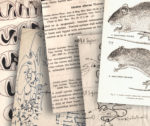A diversidade de pequenos mamíferos do Boqueirão da Onça, na Caatinga do Estado da Bahia, revelada pela maior caverna do Brasil, a Toca da Boa Vista
Jorge J. Cherem, Sandro Paulino de Faria, Patrícia HadlerCavernas são cavidades naturais subterrâneas formadas pela ação da água propícias ao acúmulo de restos de vertebrados. Na Caatinga do Estado da Bahia, a Toca da Boa Vista (TBV) destaca-se como a maior caverna do Brasil, localizada numa região coberta por floresta estacional, campos rupestres e áreas antropizadas, conhecida como Boqueirão da Onça. No presente estudo foram analisados materiais craniomandibulares e dentes de pequenos mamíferos coletados sobre o piso da TBV provenientes, em sua maior parte, das pelotas da coruja suindara (Tyto furcata). Foram registradas 31 espécies, incluindo sete de Didelphimorphia (Didelphidae), 14 de Rodentia (Caviidae, Echimyidae, Cricetidae e Muridae) e 10 de Chiroptera (Furipteridae, Natalidae, Phyllostomidae e Vespertilionidae). Todas essas espécies têm ocorrência conhecida para a Caatinga. A distribuição de Holochilus oxe é ampliada para o Estado da Bahia. Foram identificadas espécies ameaçadas (e.g., Thylamys karimii, Kerodon rupestris e Furipterus horrens), restritas aos limites do bioma ou a áreas de transição (Marmosops incanus e Pseudoryzomys simplex) e de hábitos florestais (e.g., Marmosa demerarae e Rhipidomys cariri). A ocorrência dessas espécies de pequenos mamíferos refletem os ambientes conservados na região do Boqueirão da Onça. Por outro lado, a presença de Mus musculus e Rattus rattus está relacionada aos ambientes antropizados próximos da TBV. Esses dados corroboram a relevância das cavernas como fonte de material para estudos sobre pequenos mamíferos e ampliam o conhecimento sobre a fauna da região do Boqueirão da Onça, uma das áreas mais representativas da Caatinga.
Small mammal diversity of the Boqueirão da Onça, Caatinga in the State of Bahia, revealed in Brazil’s largest cave, Toca da Boa Vista. Caves are natural underground cavities eroded by water, where vertebrates remains accumulated. Toca da Boa Vista (TBV) in the State of Bahia has importance as the largest cave in the country and is located in Boqueirão da Onça, a region covered by seasonal forest, rocky fields, and anthropized areas. We conducted an analysis of craniomandibular and dental material of small mammals collected on the surface of this cave, deposited for the most part by the owl Tyto furcata. Thirty-one species of small mammals were recorded, including seven Didelphimorphia (Didelphidae), 14 Rodentia (Caviidae, Echimyidae, Cricetidae, and Muridae), and 10 Chiroptera (Furipteridae, Natalidae, Phyllostomidae, and Vespertilionidae). All these species are known from the Caatinga. The distribution of Holochilus oxe is confirmed for Bahia. The sample includes threatened species (e.g., Thylamys karimii, Kerodon rupestris, and Furipterus horrens), restricted to bioma limits or to transitional areas (Marmosops incanus and Pseudoryzomys simplex), and ones of forest habits (e.g., Marmosa demerarae and Rhipidomys cariri). These species reflect the environments conserved within Boqueirão da Onça. On the other hand, the presence of Mus musculus and Rattus rattus is related to anthropized areas near TBV. These data support the importance of caves as a source of material for small mammals’ studies and increase the knowledge of the fauna of Boqueirão da Onça, one of the most representative areas of the Caatinga.

